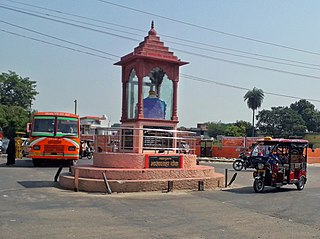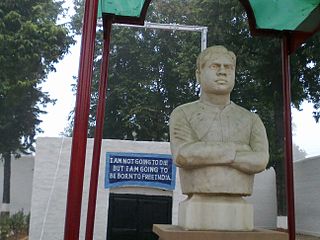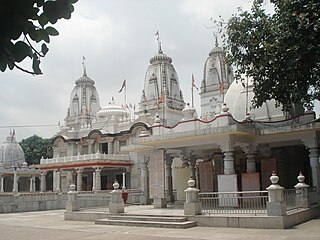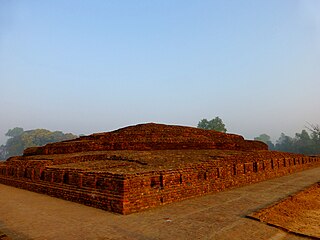Related Research Articles

Kauravi, also known as Khaṛībolī, is a dialect of Hindustani descended from Shauraseni Prakrit that is mainly spoken in northwestern Uttar Pradesh, outside of Delhi.

Harit Pradesh is a proposed new state of India comprising the western parts of the state of Uttar Pradesh. The etymology derives from harit, meaning 'green', and pradesh, meaning 'state'. Other proposed names include Braj pradesh and Paschim Pradesh. It consists of an area of 79,832 sq km, which is 33.14% of UP and a population of 7.42 crores, which is roughly 35-36% of UP.

The Hindi Belt, also known as the Hindi Heartland, is a linguistic region encompassing parts of northern, central, eastern, and western India where various Northern, Central, Eastern and Western Indo-Aryan languages are spoken, which in a broader sense is termed as Hindi languages, with Standard Hindi serving as the lingua franca of the region.
The Other Backward Class (OBC) is a collective term used by the Government of India to classify castes that are educationally or socially backward. It is one of several official classifications of the population of India, along with general castes, Scheduled Castes and Scheduled Tribes (SCs and STs). The OBCs were found to comprise 52% of the country's population by the Mandal Commission report of 1980 and were determined to be 41% in 2006 when the National Sample Survey Organisation took place. There is substantial debate over the exact number of OBCs in India; it is generally estimated to be sizable, but many believe that it is higher than the figures quoted by either the Mandal Commission or the National Sample Survey.

Budaun is a medieval city and headquarters of Budaun district, in the Indian state of Uttar Pradesh. It is located about a mile east of the Sot river, and 27 km north of the Ganges, in the Rohilkhand region of Uttar Pradesh. According to the 2011 census, it has a population of 159,221, which is projected at 161,555 at present. Budaun rose to historical importance as the capital of the Delhi Sultanate for four years from 1210 CE to 1214 CE during the reign of Sultan Iltutmish. It was the most important post of Northern Frontier during Mughal reign. Budaun is a big market, historically famous and religiously important city. Budaun is 230 km south-east of New Delhi and 245 km north-west of Lucknow, both taking about 6 hours by road.

Prayagraj district, also known as Allahabad district, is the most populous district in the Indian state of Uttar Pradesh. Prayagraj city is the district headquarters of this district. The District is divided into blocks within tehsils. As of 2011, there are 20 blocks in eight tehsils. The Prayagraj division includes the districts of Pratapgarh, Fatehpur, Kaushambi and Prayagraj, with some western parts that had previously part of Allahabad District becoming part of the new Kaushambi District. The administrative divisions are Phulpur, Koraon, Meja, Sadar, Soraon, Handia, Bara, Shringverpur and Karchana.

Ayodhya district is one of the 75 districts in the northern Indian state of Uttar Pradesh. The city of Ayodhya is its administrative headquarters. The district occupies an area of 2,522 square kilometres (974 sq mi), and had a population of 2,470,996 in the 2011 census. Ayodhya district shares its borders with 6 districts of Uttar Pradesh. It is bordered by Gonda and Basti districts on the northern side, Amethi and Sultanpur districts on the south, and Ambedkar Nagar and Barabanki districts share the border on the east and west.

The Pratapgarh district is one of the districts of Uttar Pradesh state of India, and Pratapgarh city is the district headquarters. Pratapgarh district is a part of Prayagraj division. The total area of Pratapgarh district is 3730 Sq. km.

Sant Kabir Nagar district is one of the 75 districts of Uttar Pradesh state in northern India. Khalilabad is the district headquarters. Sant Kabir Nagar district is a part of Basti division. The total area of Sant Kabir Nagar district is 1,646 km2 (636 sq mi).

Ambedkar Nagar is one of the 75 districts of the Indian state of Uttar Pradesh. This district is a part of Ayodhya division in the Awadh region of the state. This district was established on 29 September 1995 by carving out parts of the erstwhile Faizabad district. It was created by the then Chief Minister Mayawati and named in memory of B. R. Ambedkar, who worked for the advancement of the depressed classes. The total area of Ambedkar Nagar district is 2350 Sq. Km.

Gonda district is one of the districts of Uttar Pradesh, India. The city of Gonda is the district headquarters, and also the administrative centre for the Devipatan Division. The total area of Gonda district is 4,003 km2 (1,546 sq mi).

Mirzapur district is one of the 75 districts in the Indian state of Uttar Pradesh. The district is bounded on the north by Bhadohi and Varanasi districts, on the east by Chandauli district, on the south by Sonbhadra district and on the northwest by Prayagraj. The district occupies an area of 4521 km2. Mirzapur city is the district headquarters. Mirzapur district is a part of Mirzapur division. This district is known for the Vindhyavasini temple in Vindhyachal and several tourist attractions like water falls like Rajdari & Devdari and dams. It consist of several Ghats where historical sculptures are still present. During the Ganges festival these Ghats are decorated with lights and diyas.

Gorakhpur district is one of the 75 districts of Uttar Pradesh state in northern India. This district is a part of the Gorakhpur division. The city of Gorakhpur, or Gorakhpur is the administrative headquarters of this district and Gorakhpur division. It borders Sant Kabir Nagar district to the west, Kushinagar and Deoria districts to the east, and Maharajganj and Azamgarh districts to the north and south.

Lohar is considered to be a caste among Hindus and a clan among Muslims and Sikhs in the Indian states of Uttar Pradesh and Jharkhand, and in Nepal. They form traditionally artisanal castes. Writers of the Raj period often used the term Lohar as a synonym for blacksmith, although there are other traditional smiting communities, such as the Ramgarhia and Sikligar, and numerous non-traditional communities, including the Kayastha, Rajput and Brahmin.

Siddharthnagar district is one of the 75 districts of the Indian state of Uttar Pradesh. Siddharthnagar is the district headquarters. Siddharthnagar district is a part of Basti division. It was under the ancient Kosala kingdom and also the Shakya kingdoms.
At the 2011 Census, Bihar was the third most populous state of India with total population of 104,099,452, nearly 89% of it rural. It was also India's most densely populated state, with 1,106 persons per square kilometre. The sex ratio was 918 females per 1000 males. Almost 58% of Bihar's population was below 25 years age, which is the highest in India. At 11.3%, Bihar has the second-lowest urbanisation rate in India after Himachal Pradesh.

The 2011 census of India or the 15th Indian census was conducted in two phases, house listing and population enumeration. The House listing phase began on 1 April 2010 and involved the collection of information about all buildings. Information for National Population Register (NPR) was also collected in the first phase, which will be used to issue a 12-digit unique identification number to all registered Indian residents by Unique Identification Authority of India. The second population enumeration phase was conducted between 9 and 28 February 2011. Census has been conducted in India since 1872 and 2011 marks the first time biometric information was collected. According to the provisional reports released on 31 March 2011, the Indian population increased to 1.21 billion with a decadal growth of 17.70%. Adult literacy rate increased to 74.04% with a decadal growth of 9.21%. The motto of the census was Our Census, Our Future.

Islam in Uttar Pradesh is the second largest religion in the state with 38,483,967 adherents in 2011, forming 19.26% of the total population. Muslims of Uttar Pradesh have also been referred to as Hindustani Musalman. They do not form a unified ethnic community, but are differentiated by sectarian and Baradari divisions, as well as by language and geography. Nevertheless, the community shares some unifying cultural factors. Uttar Pradesh has more Muslims than any Muslim-majority country in the world except Indonesia, Pakistan, Bangladesh, Nigeria, Egypt, Iran and Turkey.

Western Uttar Pradesh is a region in India that comprises the western districts of Uttar Pradesh state, including the areas of Rohilkhand and those where Hindi and Braj are spoken. The region has some demographic, economic and cultural patterns that are distinct from other parts of Uttar Pradesh, and more closely resemble those of Haryana and Rajasthan states. The largest city of the region is Ghaziabad, while the second-largest city, Agra, is a major tourist destination.

Keshav Prasad Maurya is an Indian politician, currently serving as the Deputy Chief Minister of Uttar Pradesh. He is a member of the Bharatiya Janata Party. Maurya was associated with a right-wing Hindu organization Rashtriya Swayamsevak Sangh, before entering active politics through BJP. He was also involved in cow protectionism in his early life. Before 2017 Uttar Pradesh Legislative Assembly elections, he was made state president of the BJP, and after the victory of BJP, he was appointed as Deputy Chief Minister of Uttar Pradesh in the first Yogi Adityanath Government. Maurya again contested the legislative assembly elections in 2022 from Sirathu Assembly constituency, losing to Pallavi Patel of Samajwadi Party. However, he was given a second term as Deputy CM in the second Yogi Adityanath government.
References
- ↑ ORGI. "Census of India Website : Office of the Registrar General & Census Commissioner, India". www.censusindia.gov.in. Archived from the original on 10 May 2006. Retrieved 14 February 2018.
- ↑ "North India and south Pakistan". 23 March 2012. Archived from the original on 4 January 2017. Retrieved 4 January 2017.
- 1 2 People of India Uttar Pradesh Volume XLII edited by A Hasan & J C Das, Manohar Publications
- 1 2 3 4 "Religion PCA - State wise". Archived from the original on 16 November 2016. Retrieved 14 June 2017.
- ↑ "Archived copy" (PDF). Archived from the original (PDF) on 9 April 2011. Retrieved 2011-04-07.
{{cite web}}: CS1 maint: archived copy as title (link) - 1 2 "List of districts of Uttar Pradesh". Archived from the original on 21 September 2017. Retrieved 16 July 2017.
- ↑ C1 - Population by religious community, Uttar Pradesh. Archived 27 September 2015 at the Wayback Machine Census India 2017. Retrieved 14 February 2018.
- 1 2 3 "Total population by religious communities". Censusindia.gov.in. Archived from the original on 19 January 2008. Retrieved 20 November 2014.
- ↑ "Indian Census 2011". Census Department, Government of India. Archived from the original on 13 September 2015. Retrieved 25 August 2015.
- ↑ "'Centre not releasing caste census data because it doesn't want to face Mandal II'". Thehindubusinessline.com. 9 July 2015. Archived from the original on 3 August 2019. Retrieved 6 July 2016.
- ↑ "Centre releases census data on religion, hides caste figures". Dnaindia.com. 26 August 2015. Archived from the original on 22 September 2016. Retrieved 6 July 2016.
- ↑ "Before releasing caste numbers, the government needs to account for discrepancies in data". Scroll.in. 7 August 2015. Archived from the original on 7 May 2016. Retrieved 6 July 2016.
- ↑ "Caste-based Census data should be made public, demand Bihar CM Nitish Kumar". The Hindu. 24 June 2016. Archived from the original on 24 June 2016. Retrieved 6 July 2016.
- ↑ Shailvee Sharda. "Job better than aid, say UP dalits". The Times of India. Archived from the original on 2 November 2017. Retrieved 6 July 2016.
- ↑ "UP polls: Why is BJP hesitating in announcing its CM candidate?". Indiatvnews.com. 16 June 2016. Archived from the original on 17 June 2016. Retrieved 6 July 2016.
- ↑ "Half of India's dalit population lives in 4 states". The Times of India. 2 May 2013. Archived from the original on 11 November 2020. Retrieved 5 February 2016.
- 1 2 3 "UP has the highest OBC population". Hindustan Times . 23 October 2023. Archived from the original on 15 January 2024. Retrieved 14 January 2024.
- ↑ "Why smaller castes could hold the key to power in 2017 UP Assembly polls". 29 December 2016. Archived from the original on 28 December 2016. Retrieved 28 December 2016.
- ↑ "Survey puts OBC population at 40 pc". 3 September 2007. Archived from the original on 5 February 2016. Retrieved 5 February 2016.
- ↑ "OBC population in UP stands at 7 crore". Archived from the original on 19 February 2016. Retrieved 5 February 2016.
- ↑ "Kurmis rally against Yadav domination in Uttar Pradesh". India Today. Archived from the original on 25 May 2021. Retrieved 25 May 2021.
- ↑ "Why the most backward castes are crucial for BJP's sandwich alliance to succeed in Uttar Pradesh". 7 April 2019. Archived from the original on 10 April 2019. Retrieved 10 April 2019.
- ↑ Katiyar, Prerna (19 June 2016). "Uttar Pradesh polls: BSP, SP and BJP leaving no stone to come up trumps". The Economic Times. Archived from the original on 18 June 2016. Retrieved 19 June 2016.
- ↑ "BJP joins race for Brahmin votes with 'prabuddha varg sammelans' in UP". Economic Times. 6 September 2021. Archived from the original on 8 February 2022. Retrieved 8 February 2022.
Brahmins constitute 13 per cent of the population and are considered as major opinion makers in Uttar Pradesh.
- 1 2 Hebbar, Nistula (3 May 2019). "BJP striving to please Rajputs and Brahmins". The Hindu. ISSN 0971-751X. Archived from the original on 18 September 2020. Retrieved 3 June 2019.
- ↑ "How BJP is changing the caste arithmetic in Uttar Pradesh | Latest News & Updates at Daily News & Analysis". Dnaindia.com. 1 May 2014. Archived from the original on 6 December 2017. Retrieved 8 March 2017.
- ↑ "Uttar Pradesh, the darling of 2014 | 5Forty3". Archived from the original on 8 March 2016. Retrieved 2016-02-15.
- ↑ "UP govt declares holiday on Maharana Pratap Jayanti to 'woo' Thakur voters". English.pradesh18.com. 8 May 2015. Archived from the original on 9 January 2017. Retrieved 8 March 2017.
- ↑ "Brahmins population in India". Archived from the original on 10 January 2016. Retrieved 5 February 2016.
- ↑ "Uttar Pradesh Assembly Elections 2017 | Indian National Congress | AAP | BJP | NDA | Samajwadi Party | Candidates List | Opinion Poll | Exit Poll | Election News Malayalam". Manoramaonline.com. Archived from the original on 19 May 2017. Retrieved 8 March 2017.
- 1 2 Experts, Disha (1 July 2020). Amazing Uttar Pradesh - General Knowledge for UPPSC, UPSSSC & other Competitive Exams. Disha Publications. ISBN 978-93-90486-72-4. Archived from the original on 27 April 2023. Retrieved 30 September 2022.
- ↑ People of India: Uttar Pradesh Volume XLII Part One edited by A Hasan & J C Das pages 21 to 23 Manohar Publications
- ↑ "The Slow Death of Awadhi and Bhojpuri". Archived from the original on 7 September 2023. Retrieved 7 September 2023.
- ↑ "Omniglot — Awadhi (अवधी)". Archived from the original on 7 September 2023. Retrieved 7 September 2023.
- ↑ "'Awadhi language is grouped as mother tongue under Hindi' says Minister of State for Home Affairs". Archived from the original on 7 September 2023. Retrieved 7 September 2023.
- ↑ "Going Native: Ghalib goes to Awadh…". Archived from the original on 7 September 2023. Retrieved 7 September 2023.
- ↑ "Bhojpuri". Ethnologue. Archived from the original on 29 November 2017. Retrieved 8 September 2022.
- ↑ Koskoff, Ellen (2008). The Concise Garland Encyclopedia of World Music: The Middle East, South Asia, East Asia, Southeast Asia. Routledge. ISBN 978-0-415-99404-0.
- ↑ Hasan, Amir; Das, J. C.; Rizvi, Baqr Raza (2005). People of India: Uttar Pradesh. Anthropological Survey of India. ISBN 978-81-7304-114-3.
- ↑ Grierson, George Abraham (1881). A handbook to the Kayathi character. The Library of Congress. Calcutta, Thacker, Spink, and co.
- ↑ C-16 Population By Mother Tongue – Uttar Pradesh (Report). Office of the Registrar General & Census Commissioner, India. Archived from the original on 30 April 2021. Retrieved 15 July 2020.